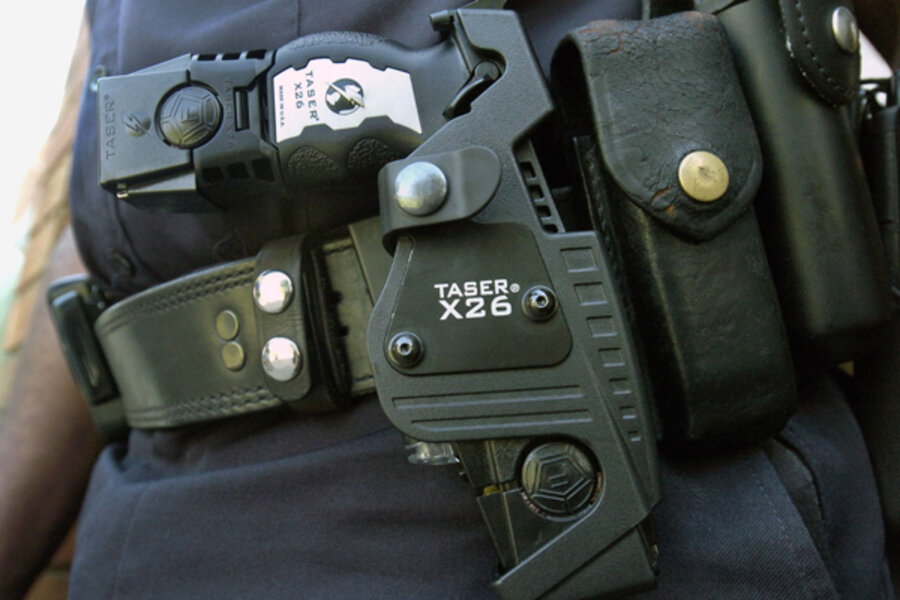Federal court in California limits police use of Tasers
Loading...
| San Francisco
In a decision that could alter how law enforcement agencies nationwide use stun guns, a federal appeals court panel this week ruled that a California police officer was not immune from civil litigation resulting from questionable use of the controversial weapon.
The US Ninth Circuit Court of Appeals on Monday removed a legal roadblock holding up a lawsuit against Coronado, Calif., police officer Brian McPherson, who fired his Taser stun gun at motorist Carl Bryan after a 2005 traffic stop.
Mr. Bryan sued Officer McPherson, the Coronado Police Department, and the City of Coronado for excessive force, assault, and infliction of emotional stress. A lower court ruled that Coronado and its police department were immune from the case but not the officer because he used the electroshock weapon in a way that appeared to be unreasonable and unlawful. The appeals court affirmed that ruling.
If the ruling is not overturned by the US Supreme Court, it could change how as many as 11,500 US law enforcement agencies currently use their stun guns. Many agencies, according to experts, give officers wide latitude in determining the appropriate use of the weapons. The ruling now raises the bar for when the weapons can be deployed, stating that while stun guns are considered nonlethal weapons, they dispense a level of force that must be justified by a “strong government interest.”
The use of stun guns should be limited to situations where there is "an immediate threat to the officer or a member of the public," wrote Judge Kim Wardlaw, who penned the court's opinion.
What justifies use of a Taser?
In an earlier case, the US Supreme Court said three factors determine "government interest:" the severity of the crime, whether the suspect posed a serious threat to officer safety, and whether the suspect was evading or resisting arrest.
The traffic stop involving McPherson and Bryan didn’t meet any of those standards, the Ninth Circuit court found.
There’s no question, the court said, that Bryan was acting erratic and irrational after McPherson stopped him for not wearing his seatbelt. He was dressed only in boxer shorts and shoes, and was yelling and hitting himself. But the court found he still didn’t pose enough of a threat to the officer to justify the use of the Taser gun.
“Officer McPherson stopped Bryan for the most minor of offenses. There was no reasonable basis to conclude that Bryan was armed. He was twenty feet away and did not physically confront the officer,” Judge Wardlaw wrote, adding, “The facts suggest that Bryan was not even facing Officer McPherson when he was shot. A reasonable officer in these circumstances would have known that it was unreasonable to deploy intermediate force.”
In cases where suspects appear mentally ill, the court found, officers should apply even more caution before using stun guns. "[If] Officer McPherson believed Bryan was mentally disturbed, he should have made greater effort to take control of the situation through less intrusive means," Wardlaw wrote.
While Taser weapons have been considered nonlethal in the courts, the federal circuit court said the guns should not be treated like other nonlethal weapons such as pepper spray and batons. “The physiological effects, the high levels of pain, and foreseeable risk of physical injury lead us to conclude that [stun guns] are a greater intrusion than other non-lethal methods of force we have confronted,” Wardlaw wrote.
Law enforcement groups react
Human rights groups have been critical of Tasers and other conducted energy devices, or CEDs, as their use has spread among police departments in the US and elsewhere. A 2008 Amnesty International report says that since June 2001, more than 330 people in the USA have been reported to have died after being struck by police Tasers and 25 similar deaths reported in Canada.
But many law enforcement groups as well as Taser International, the makers of the stun gun, credit the weapons with protecting officers and reducing suspect injuries. “Taser devices have reduced officer and suspect injures by as much as 30 to 80 percent in some communities,” a statement on the Taser International wesbite says.
Many police departments allow the stun guns to be deployed even when suspects are not violent or an immediate threat, experts say.
“Some departments allow Tasers in cases of passive resistance, such as protesters who won't move," Michael Gennaco, who has studied the use of Taser weapons in Los Angeles, told the Los Angeles Times. He said the ruling would end the use of Taser in cases of passive resistance.
Answering questions at a news conference Tuesday, San Francisco Police Chief George Gascon called the Taser device “a sophisticated weapon system to be used under the right circumstance ... It should be used when officers fear being assaulted."
San Francisco is one of the few police departments where officers are not outfitted with stun guns. Chief Gascon would like to see that change.
---
Follow us on Twitter.





